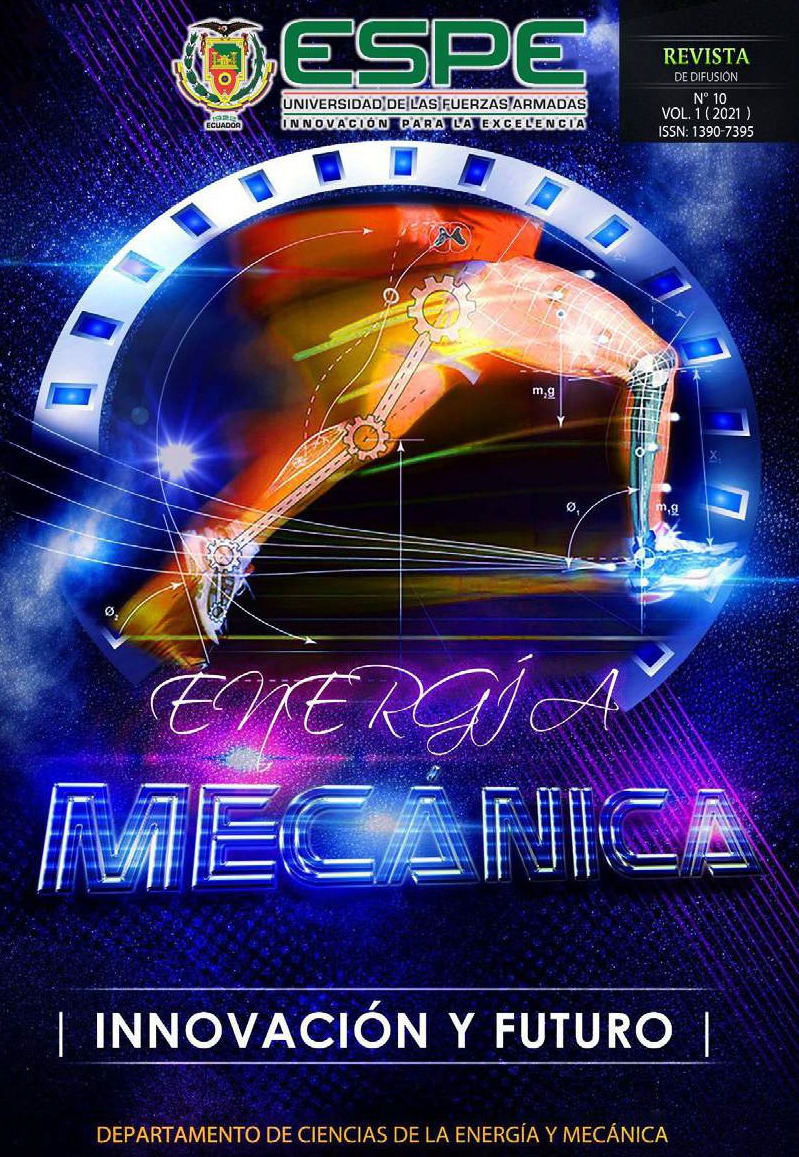ANÁLISIS MECÁNICO ESTRUCTURAL DE PROTOTIPO PARAREHABILITACIÓN EN ADULTOS MAYORES CON PROBLEMAS DETENDINITIS
DOI:
https://doi.org/10.24133/EMIF.V10.8i.3904Abstract
En la última década se ha evidenciado la necesidad de
incluir la tecnología en el área de la medicina, dado
por las extensas ventajas que aporta incluir sistemas
electrónicos en diferentes áreas de la salud. De esta
manera ampliando y complementando las capacidades
de personal médico, debido a que la ingeniería se
integra de forma efectiva conjuntamente con diseños
mecánicos que permiten mejorar los procesos de
rehabilitación o fisioterapia de adultos mayores.
Es por ello que en el presente trabajo se desarrolló
una estructura mecánica que conjuntamente con un
sistema electrónico permite monitorear el avance de la
rehabilitación de personas que padezcan de tendinitis
o en la prevención de dicha enfermedad. Dado que la
estructura está dirigida a personas adultas se analiza la
resistencia de la estructura mecánica y fluencia según
Von Mises, conjuntamente con el factor de seguridad
para determinar la vida útil estimada del prototipo
utilizando herramientas como ANSIS y Solid Works.
Palabras Clave: Rehabilitación, Tendinitis, Análisis
mecánico
Abstract
In the last decade it has become evident the need to
include technology in the area of medicine, given the
extensive advantages of including electronic systems
in different areas of health. In this way expanding and
complementing the capabilities of medical personnel,
because engineering is effectively integrated with
mechanical designs that allow improving the
processes of rehabilitation or physiotherapy of older
adults. That is why in the present work a mechanical
structure was developed that together with an
electronic system allows monitoring the progress of
the rehabilitation of people suffering from tendinitis
or in the prevention of this disease. Since the structure
is aimed at adults, the resistance of the mechanical
structure and creep according to Von Mises, together
with the safety factor to determine the estimated useful
life of the prototype is analyzed using tools such as
ANSIS and Solid Works.
Keywords: Rehabilitation, Tendinitis, Structural
analysis
Referencias
[1] Niering, M.; Muehlbauer, T. Effects of Physical
Training on Physical and Psychological
Parameters in Individuals with Patella Tendon
Myopathy: A Systematic Review and MetaAnalysis. Sports 2021, 9, 12. https://doi.
org/10.3390/sports9010012.
[2] Michael, E.; White, M.J.; Eves, F.F. Home-Based
Stair Climbing as an Intervention for Disease
Risk in Adult Females; A Controlled Study. Int.
J. Environ. Res. Public Health 2021, 18, 603.
https://doi.org/10.3390/ijerph18020603
[3] Kosar, T.; Lu, Z.; Mernik, M.; Horvat, M.;
Črepinšek, M. A Case Study on the Design
and Implementation of a Platform for Hand
Rehabilitation. Appl. Sci. 2021, 11, 389. https://
doi.org/10.3390/app11010389
[4] Moreno Naya, D.; Vazquez-Araujo, F.J.; Castro,
P.M.; Vivas Costa, J.; Dapena, A.; González
Doniz, L. Utilization of a Mobile Application
for Motor Skill Evaluation in Children. Appl.
Sci. 2021, 11, 663. https://doi.org/10.3390/
app11020663.
[5] Miao, M.; Gao, X.; Zhu, W. A Construction
Method of Lower Limb Rehabilitation Robot
with Remote Control System. Appl. Sci. 2021,
11, 867. https://doi.org/10.3390/app11020867
[6] R. K. Shian, U. T. Hoang Le, J. L. Yong, N. H.
Jenq, H. Y. Jang y H. C. Kyoung, «A Review
on Video-Based Human Activity Recognition,»
Computers, 2013.
[7] S. Sanchez, D. Monekosso, P. Remagnino, D.
Vallejo y C. González, «Automatic recognition of
physical exercises performed by stroke survivors
to improve remote rehabilitation» IEEE, 2019.
[8] O. Pastolache, «Remote sensing technologies for
physiotherapy assessment,» IEEE, 2017.
[9] Q. Xu, X. Xiong, G.-L. Feng, M. Jing Guo y L.
Wan, «Design of Intelligent Campus Multimedia
Interactive System Based on Internet of Things
Technology» IEEE, 2019.
[10] R. Aranha, L. Araujo, C. Monteiro, T. Da Silva
y F. Nunes, «MoVEROffice: Virtual Reality for
Upper Limbs Rehabilitation,» IEEE, 2016.
[11] Poo, T. S., & Sundaraj, K. (2010, May). Design
and development of low cost biceps tendonitis
monitoring system using EMG sensor. In 2010 6th
International Colloquium on Signal Processing &
its Applications (pp. 1-5). IEEE
[12] Costa, J. G., Peixoto, L. R. T., Miosso, C. J.,
Macedo, F. S., Da Rocha, A. F., & Perez, F. S.
B. (2014, April). Protocols for physiotherapic
treatment of pain due to shoulder tendinopathies.
In 2014 Pan American Health Care Exchanges
(PAHCE) (pp. 1-5). IEEE.
[13] Choi, S., Lee, G. J., Lee, S., Cheong, Y.,
Kwon, E., Cho, H., ... & Park, H. K. (2011,
October). Effect of extracorporeal shockwave
therapy on nanostructural and property responses
of the Achilles tendinitis rat model. In 2011
IEEE Nanotechnology Materials and Devices
Conference (pp. 425-427). IEEE.
[14] Yeo, J. C., Lee, C., Wang, Z., & Lim, C.
T. (2016, October). Tactile sensorized glove
for force and motion sensing. In 2016 IEEE
SENSORS (pp. 1-3). IEEE.
[15] Horng, M. H. (2008, May). Texture
Characteristics for Classification of the
Ultrasonic Images of Roator Cuff Disease. In
2008 International Conference on BioMedical
Engineering and Informatics (Vol. 2, pp. 258-
262). IEEE.
[16] Ren, Y., Wu, Y. N., Yang, C. Y., Xu, T., Harvey, R.
L., & Zhang, L. Q. (2016). Developing a wearable
ankle rehabilitation robotic device for in-bed
acute stroke rehabilitation. IEEE Transactions on
Neural Systems and Rehabilitation Engineering,
25(6), 589-596.
Downloads
Published
Issue
Section
License
Los autores que publican en esta revista están de acuerdo con los siguientes términos:
Los autores conservan los derechos de autor y garantizan a la revista el derecho de ser la primera publicación del trabajo al igual que licenciado bajo una Creative Commons Attribution License que permite a otros compartir el trabajo con un reconocimiento de la autoría del trabajo y la publicación inicial en esta revista.
Los autores pueden establecer por separado acuerdos adicionales para la distribución no exclusiva de la versión de la obra publicada en la revista (por ejemplo, situarlo en un repositorio institucional o publicarlo en un libro), con un reconocimiento de su publicación inicial en esta revista.
Se permite y se anima a los autores a difundir sus trabajos electrónicamente (por ejemplo, en repositorios institucionales o en su propio sitio web) antes y durante el proceso de envío, ya que puede dar lugar a intercambios productivos, así como a una citación más temprana y mayor de los trabajos publicados.

